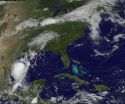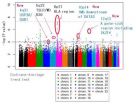(Press-News.org) NASA is analyzing Tropical Storm Don from all angles, inside and out, using three different satellites. Don is expected to make landfall in southeastern Texas tonight or early Saturday.
NASA's Aqua satellite passed over Tropical Storm Don at 8:17 UTC (4:17 a.m. EDT) on July 29. The instrument called the Atmospheric Infrared Sounder (AIRS) took the temperature of Don's clouds in an infrared image. AIRS data revealed a large area of powerful, high thunderstorms with cold cloud tops surrounding Don's center where cloud temperatures were colder than -63 Fahrenheit (-52 Celsius). The higher the thunderstorm cloud-top, the colder it is, and the more powerful they are.
When the GOES-13 satellite passed over Don at 1402 UTC (10:02 a.m. EDT) this morning, July 29, it captured a picture that showed the fringe of the tropical storm's western edge was just brushing coastal Texas on its approach to landfall. The GOES-13 satellite is managed by NOAA and keeps an eye on all weather in the eastern half of the U.S. The NASA/NOAA GOES Project at NASA's Goddard Space Flight Center in Greenbelt, Md. created the image that showed the strongest thunderstorms around the center of circulation. In the image, the highest thunderstorms around the storm's center cast small shadows on the lower clouds.
Those high thunderstorms around the center have been dropping heavy rainfall since July 28, when the Tropical Rainfall Measuring Mission satellite (TRMM) passed overhead. TRMM can measure rainfall from its orbit in space and passed over Don at 0609 UTC (1:09 a.m. CDT). At that time, Don's center was north of Mexico's Yucatan peninsula, where Don was located at that time. A TRMM rainfall analysis showed Don was dropping moderate to heavy rainfall of up to 2 inches/50 mm per hour in the eastern side of the small storm. Most of the other rainfall was moderate, falling between .78 to 1.57 inches (20 to 40 mm) per hour.
With NASA and NOAA satellites confirming that Don is bringing heavy rainfall and gusty winds, a tropical storm warning is in effect for the Texas coast from the mouth of the Rio Grande to Matagorda as tropical storm-force conditions are expected within the warning area by late today.
According to NOAA's National Hurricane Center, at 11 a.m. EDT (1500 UTC) on July 29, 2011, Tropical Storm Don's maximum sustained winds were near 50 mph (85 km/h) with higher gusts. Tropical storm force winds extend outward up to 105 miles (165 km) from the center, so Don has expanded to 210 miles, since yesterday when the storm was 180 miles in diameter.
The center of Tropical Storm Don was located near latitude 26.2 North and longitude 94.9 West. Don is moving toward the west-northwest near 14 mph (22 km/h) and is expected to continue moving on that track for the next day or two. The estimated minimum central pressure is 1002 millibars.
So what can residents of southern Texas and northern Mexico expect from Don? According to the National Hurricane Center (NHC), storm surge will make water levels rise as much as 2 feet above ground level, mostly along the immediate coast and to the northeast of where Don's center makes landfall. Regardless, all residents in the warning area can expect rough surf and damaging waves.
The heavy rainfall that NASA's TRMM satellite saw on July 28 within Don will bring 3 to 5 inches in south Texas and extreme northeastern Mexico. The NHC noted that isolated totals to 7 inches are even possible. Residents should also be prepared for the tropical storm-force winds and the possibility of isolated tornadoes over south Texas today and tonight as Don begins making landfall.
INFORMATION:
Tropical Storm Don analyzed in 3 NASA satellite images
2011-08-01
ELSE PRESS RELEASES FROM THIS DATE:
AGU journal highlights -- July 29, 2011
2011-08-01
The following highlights summarize research papers that have been
recently published in Geophysical Research Letters (GRL); Space
Weather; Geochemistry, Geophysics, Geosystems (G-Cubed); Journal of Geophysical Research-Biogeosciences (JGR-G); Journal of Geophysical Research-Earth Surface (JGR-F); Journal of Geophysical Research-Space Physics (JGR-A) and Water Resources Research (WRR).
In this release:
What do sea measurements reveal about Earth's temperature trend?
Japan's big earthquake shook the ionosphere
Miniature detector measures deep space radiation
New ...
Computational chemistry shows the way to safer biofuels
2011-08-01
Replacing gasoline and diesel with plant-based bio fuels is crucial to curb climate change. But there are several ways to transform crops to fuel, and some of the methods result in bio fuels that are harmful to health as well as nature.
Now a study from the University of Copenhagen shows that it is possible to predict just how toxic the fuel will become without producing a single drop. This promises cheaper, faster and above all safer development of alternatives to fossil fuel.
Solvejg Jorgensen is a computational chemist at the Department of Chemistry in Copenhagen. ...
Discovery of a new magnetic order
2011-08-01
Physicists at Forschungszentrum Jülich and the universities of Kiel and Hamburg are the first to discover a regular lattice of stable magnetic skyrmions – radial spiral structures made up of atomic-scale spins – on a surface instead of in bulk materials. Such tiny formations could one day form the basis of a new generation of smaller and more efficient data storage units in the field of information technology. The scientists discovered the magnetic spirals, each made up of just 15 atoms, in a one-atomic-layer of iron on iridium. They present their results in the current ...
National asthma genetics consortium releases first results
2011-08-01
A new national collaboration of asthma genetics researchers has revealed a novel gene associated with the disease in African-Americans, according to a new scientific report.
By pooling data from nine independent research groups looking for genes associated with asthma, the newly-created EVE Consortium identified a novel gene association specific to populations of African descent. In addition, the new study confirmed the significance of four gene associations recently reported by a European asthma genetics study.
The findings, published in Nature Genetics, are a promising ...
Physics could be behind the secrets of crop-circle artists
2011-08-01
In this month's edition of Physics World, Richard Taylor, director of the Materials Science Institute at the University of Oregon, takes a serious, objective look at a topic that critics might claim is beyond scientific understanding – crop circles.
As the global crop-circle phenomenon grows alongside advances in science and technology, Taylor notes how physics and the arts are coming together to produce more impressive and spectacular crop-circle patterns that still manage to maintain their mystery.
Today's crop-circle designs are more complex than ever, with some ...
Dissecting the genomes of crop plants to improve breeding potential
2011-08-01
Scientists on the Norwich Research Park, working with colleagues in China, have developed new techniques that will aid the application of genomics to breeding the improved varieties of crop needed to ensure food security in the future. By dissecting the complicated genome of oilseed rape they have been able to produce maps of the genome that are needed for predictive breeding.
Traditional breeding involves crossing two varieties and selecting the best performing among the progeny. Predictive breeding is a more advanced technique where specific parts of the genome most ...
Columbia engineering innovative hand-held lab-on-a-chip could streamline blood testing worldwide
2011-08-01
New York, NY—July 31, 2011—Samuel K. Sia, assistant professor of biomedical engineering at Columbia Engineering, has developed an innovative strategy for an integrated microfluidic-based diagnostic device—in effect, a lab-on-a-chip—that can perform complex laboratory assays, and do so with such simplicity that these tests can be carried out in the most remote regions of the world. In a paper published in Nature Medicine online on July 31, Sia presents the first published field results on how microfluidics—the manipulation of small amounts of fluids—and nanoparticles can ...
Genome-wide study reveals 3 new susceptibility loci for adult asthma in Japanese population
2011-08-01
Researchers at the RIKEN Center for Genomic Medicine (CGM), together with colleagues at Kyoto University, Tsukuba University, Harvard University, and other medical institutions have identified three new loci associated with susceptibility to adult asthma in the Japanese population. The findings appear in Nature Genetics and derive from a genome-wide study of 4836 Japanese individuals.
Around the world, hundreds of millions of people suffer from bronchial asthma, a chronic inflammatory disease characterized by symptoms of wheezing, shortness of breath and coughing. In ...
Researchers discover the mechanism that determines cell position in the intestinal epithelium
2011-08-01
How do cells know where to position themselves and where to accumulate in order to carry out their functions correctly within each organ? Researchers with the Colorectal Cancer Lab at IRB Barcelona have revealed the molecular mechanisms responsible for organizing the intestinal epithelium into distinct comportments, defined by frontiers or territories. The study, headed by Eduard Batlle, coordinator of the Oncology Programme at IRB Barcelona and ICREA Research Professor, is published in today's online version of the Journal Nature Cell Biology, part of the prestigious editorial ...
CSHL scientists reveal mechanism behind 'oncogene addiction' in acute leukemia
2011-08-01
Cold Spring Harbor, NY – A team of scientists at Cold Spring Harbor Laboratory (CSHL) has laid bare the mechanism behind a phenomenon called oncogene addiction in mice suffering from a form of leukemia that mimics acute myelogenous leukemia (AML) in humans. Significantly, the team was able to mobilize their newly gained understanding to target "addiction" pathways in the model mice, resulting in rapid and complete eradication of the cancer, which is usually fatal and resistant to conventional chemotherapy.
Oncogene addiction refers to the curious phenomenon that cancer ...



